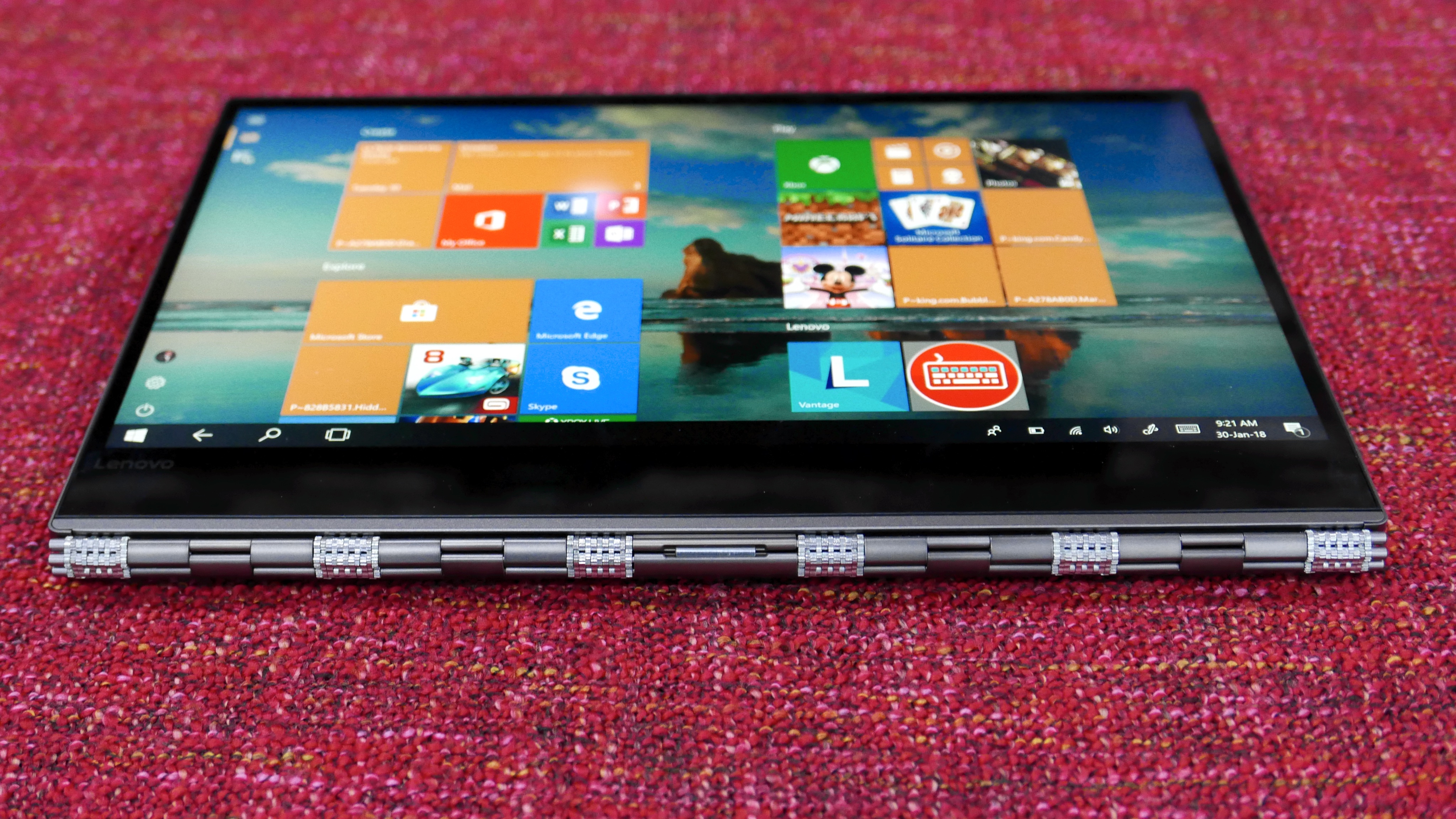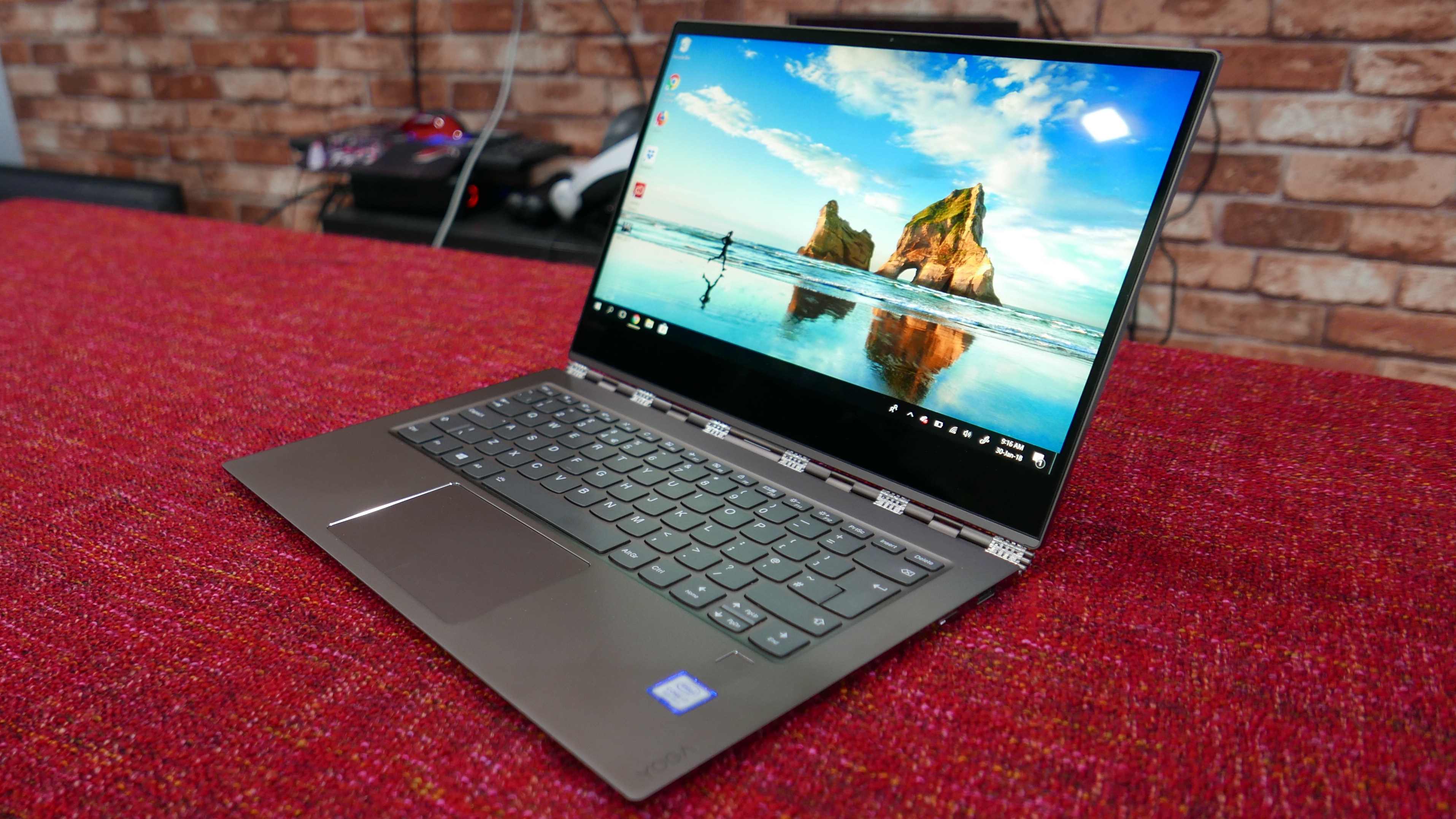TechRadar Verdict
Lenovo has produced another gorgeous 2-in-1 laptop that can transform into a tablet-like device. It’s a premium product with a price tag to match, but you feel like you’re getting your money’s worth with this accomplished device.
Pros
- +
Great design
- +
Decent power
- +
Very good sound quality
Cons
- -
Lacks graphical power
- -
Fans can be loud when they kick in
- -
Plastic stylus-holder feels cheap
- -
No SD card slot
Why you can trust TechRadar
The Lenovo Yoga 920 is follow-up to the fantastic Yoga 910 and features USB-C ports, an improved webcam location, a better keyboard and boosted battery life, while retaining the 360-degree hinge that's a hallmark of the Yoga range.
However, 2017 has been an exemplary year for convertible laptops, with devices such as the recently-released Microsoft Surface Book 2 really pushing the boundaries of what we should expect from the form factor.
That means the Yoga 920 has its work cut out if it's to really stand out from the crowd. Can it succeed? Read on to find out.

Here is the Lenovo Yoga 920 configuration sent to TechRadar for review:
CPU: 1.8GHz Intel Core i7-8550U (dual-core, 4MB cache, up to 4GHz)
Graphics: Intel UHD Graphics 620
RAM: 8GB DDR4
Screen: 13.9-inch UHD (3840 x 2160)
Storage: 512GB PCIe SSD
Ports: 1 x USB 3.0, 2 x USB-C (Thunderbolt 3), headset jack
Connectivity: 802.11ac (2.4 & 5GHz); Bluetooth 4.1
Camera: 720p
Weight: 1.37kg
Size: 323 x 223.5 x 13.95mm (W x D x H)
Price and availability
As with other 2-in-1 devices, the Lenovo Yoga 920 comes in a couple of different configurations. Thankfully Lenovo hasn't gone overboard by offering a confusing array of options.
The first model comes with an Intel Core i7-8550U processor, 512GB SSD, 8GB RAM, a 13.9-inch UHD touchscreen and an Active Pen stylus, and costs AED 6,699.
A second model comes with the same CPU as above, but features more RAM at 16GB and a larger 1TB SDD. This costs AED 7,699, though at the time of this review it was listed at 8,398 on souq.com.
While these are hefty sums to be parting with, they are around the price we normally see high-end and premium laptops and ultrabooks sell for, and they're still a fair bit cheaper than the Surface Book 2 (13.5-inch), the smaller version of Microsoft’s 2-in-1, which is comparable to the Yoga 910 in terms of size and power.
It's worth noting that none of the Lenovo 920 configurations come with a dedicated graphics card. Instead they come with less powerful integrated cards which can handle most tasks absolutely fine, but will suffer when it comes to gaming and video-editing.
Overall, though, we feel the prices are good for the various Yoga 920 configurations, and while they're certainly not cheap, these aren't ludicrous asking prices for the quality of device you’re getting.

Design
When you’re paying a premium price you want a device that looks – and feels – premium as well, and Lenovo has done an excellent job of that with the Yoga 920. It has a thin yet sturdy feel to it, weighing 1.37kg and measuring just 323 x 223.5 x 13.95mm.
This means it has a nice heft, without feeling heavy or bulky. It also has a metallic finish which adds to the premium feel, although after only a few hours of use the metal became a veritable haven for fingerprints, so you may want to keep a small cloth handy to keep it smudge-free.

It’s a small price to pay, however, for such a good-looking 2-in-1. The hinges along the back of the Yoga 920 are also eye-catching – we’ve fluctuated between thinking they're stylish and finding them a bit gaudy. There’s no doubting the strength and build quality of the hinge though, which is essential for a convertible laptop as that hinge is likely to see a lot of action as you flip the screen orientation, so you don’t want it to be a point of failure.

Like the hinge on the Surface Book 2, it’s strong enough to angle the screen without the body tipping up, while the screen remains held in place. Unlike the Surface Book 2, however, the design of this hinge doesn’t stick out quite as much, and, of course, it can flip the screen a full 180 degrees.
2-in-1 convertibles that flip their screens to turn into a tablet-like device struggle to provide quite as good a tablet experience as 2-in-1s on which the screen detaches from the keyboard, as you’re still left with a slightly bulky device with a back that feels like a keyboard (because it is one).

Lenovo has managed to address at least one of these points thanks to the thinness of the design – even with the screen flipped all the way back this is still a thin device, though not quite as slim as standard tablets. That keyboard back remains, and while it doesn’t feel that nice (compared to the smooth, flat back of a normal tablet), it's at least clever enough to turn off the buttons, so they don’t interfere when in tablet mode.
Because of this we’d recommend the Yoga 920 as a laptop that can occasionally turn into a tablet, rather than vice versa. If you’re looking for something that you’ll use mostly as a tablet, but want it to also turn into a laptop-like device for typing on, we’d recommend something like the Surface Book 2, or perhaps a tablet that comes with a physical Bluetooth keyboard.
The bezel around the screen is reasonable thin except for the bottom where it does look a bit chunky. On the Yoga 910 the webcam was housed in the bottom bezel, which led to some unflattering shots, and in general people weren’t too happy with that placement. Thankfully Lenovo has moved it to the top of the screen without making the top bezel any larger.
Given the thinness of the design, it’s probably no surprise that ports-wise there aren't a huge number of connectivity options. On the left-hand side there’s a headphone/mic jack and two USB-C ports (one of which is also used as the power supply), and on the right is a full-size USB 3.0 port. This isn’t the most generous offering, but it’s more than the MacBook’s single USB-C port.
To be honest, we didn't find the number of ports restrictive, and it’s a reasonable trade-off for the svelte design. If you have a number of USB devices that you want to attach you’ll need an adapter, though the Yoga 920 also has built-in Bluetooth support.
The fact that it still features one full-size USB port means there’s some flexibility here for using legacy devices, as well as memory sticks.

Stylus pros and cons
One thing we complained about with the Surface Book 2 devices was that despite their high prices the Surface Pen stylus wasn't included, necessitating an extra outlay on top of an already expensive purchase.
Thankfully Lenovo hasn't followed suit, and has included its Active Pen stylus as part of the package. This battery-powered stylus has a nice design, and the Yoga 920 responds well to it thanks to its screen being able to detect 4,096 levels of pressure. Light presses and hard presses were registered accurately in the art apps we tried, and the 920 kept up with even the most frantic scribbles.
Unlike the Surface Pen, which has a nifty feature where you can use the other end of the stylus as an eraser, you need to hold down one (of two) buttons on the stylus to engage erase mode. Overall, though, we were pleased with the Active Pen, and we’re very pleased that Lenovo saw fit to include it with the Yoga 920 as standard.
However, it's not all good news. Lenovo had to find a way to easily store the stylus within such a slim design. Microsoft’s solution with the Surface Pen and its Surface devices is to magnetically attach the stylus to the body of the main device; it's a nice feature that’s handy, though not completely secure, and it helps to give those devices a premium feel.

However, for the Yoga 920 Lenovo has decided on a plastic holder that slots into the full-size USB port and holds the stylus there. This ends up feeling a bit cheap and tacky, and it also means you’re losing access to a USB port while you're using it. It’s a shame, as so many other elements of the Yoga 920's design feel premium, and this just feels like a fudge.

Abbas has been living and breathing tech before phones became smart or clouds started storing data. It all started when he got his very first computer- the Sinclair ZX Spectrum. From computers to mobile phones and watches, Abbas is always interested in tech that is smarter and smaller because he believes that tech shouldn’t be something that gets added to your life- it should be a part of your life.
